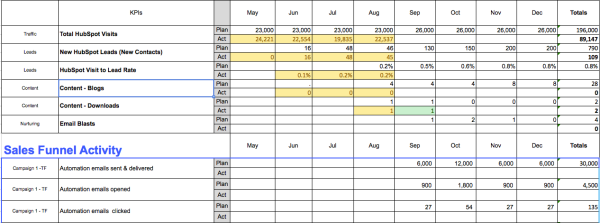
Top 10 Inbound Marketing KPIs—The View From the Top

What's in your Inbound Marketing scorecard? At a glance, can your Senior Management Team evaluate the progress of your inbound marketing program, ask the right questions and draw reasonable conclusions? If so, you have the ability to make adjustments to your strategy and campaigns with the goal of optimizing key performance indicators and achieving business goals. If not, you have a lot of 'splaining to do. Without a ledger of Management-blessed KPIs, you may be reporting misleading data, leading to the wrong conclusions. Here are my Top 10 Inbound Marketing KPIs for Executives and Board members. I'll start with the most important.
#1 - Sales Revenues From Inbound Marketing
This is the bottom line, of course. Month over month, year over year, how much revenue are your Inbound Marketing campaigns bringing in? You'll have to define what you mean by "inbound" and "outbound," for example PPC campaigns that go straight to a "buy now" landing page should probably be treated as outbound. You need to develop your content marketing and lead conversion strategy to capture these differences, for example using different landing pages and A/B tests for different types of campaigns and tactics. The other crucial thing is capturing sales data directly via CRM integration and closed-loop reporting.
#2 - Customer Acquisition Costs - Inbound vs Outbound
Calculating Customer Acquisition Costs (CAC) also requires integration of your marketing automation and CRM platforms, plus careful accounting for all of the relevant costs, possibly via ERP integration. On the outbound side: advertising, marketing distribution, manpower (both sales and marketing), plus overhead. On the inbound side: manpower (both creative and technical), software, and general overhead. Now you can directly account for new sales from both Inbound and Outbound Marketing and assign CAC on a monthly basis. You can break this down even further by campaign types to assess their relative success rates and profitability. You can find a relatively simple CAC formula here.
#3 - Customer Lifetime Value
Inbound Marketing should be ideal for reaching out to your existing customers, reducing churn and expanding their lifetime value (LTV). Turning your lead nurturing campaigns inward to reach out to existing customers presents a great opportunity to keep them engaged, inform them about new use-cases and products, and help them to get the best out of their installed base. This also represents a non-invasive way for your sales team to upsell and cross-sell. A simple calculator for LTV can be found here. For a more sophisticated approach, check out this article.
#4 - Inbound Marketing ROI
The only reason I didn't make ROI #1 is that you need the basic data in 1-3 to make this calculation. HubSpot has a great inbound marketing ROI calculator here that's useful not only in assessing monthly and annual performance, but also in planning marketing strategy and budgets. This KPI largely determines the future course of Inbound Marketing in your organization. If revenues and LTV increase year-over-year while CAC and churn decrease, you are getting the job done.
#5 - Website Traffic to Marketing Leads
Website traffic is an important metric, but by itself, it's misleading. Senior Managers are looking for sales revenues, not traffic. What you want to capture and compare month-to-month is:
- Website traffic (unique visits)
- Overall marketing leads (form conversions)
- Visit-to-lead conversion rate
- Traffic, leads and conversion rate by source (organic search, direct, website referrals, email, ppc, social media and direct marketing)
You should also break these metrics down by individual campaigns to compare tactics, content, timing, target segmentation and other more subtle factors. This data will allow your Senior Managers to judge the effectiveness of your marketing efforts and their impact on the bottom line.

#6 - Marketing to Sales Conversion Rates
By integrating your marketing automation and CRM systems, you can directly calculate both sales qualified lead (SQL) conversion rates and sales accepted lead (SAL) conversion rates. Sales qualified leads would be those leads that are automatically flagged as sales-ready via lead scoring or specific triggers, such as a "contact a rep" form conversion. Sales accepted leads would be those that have been directly accepted by sales reps as opportunities in the CRM and either have been contacted directly or are scheduled for a call. These KPIs are most useful for sales and marketing executives to make sure their processes are optimized for capturing qualified leads, passing them along to sales at the right time and enabling high-close rates.
#7 - Landing Page (Content) Conversion Rates
How well is your content marketing working? The only true metric is landing page conversions for your ebooks, white papers, videos and webinars. You want to track all of your public facing offers so that you can compare conversion rates. Don't forget to optimize your landing pages and calls to action with A/B split tests, track your tests and double down on the winners.
#8 - Organic Searches
I'm going to break this category down into several business-related metrics. No, none of them involve Google page rank. That particular metric may be interesting, but it's very hard to translate into sales and marketing ROI.
- # Lead Conversions assisted by organic search (an indication of relevance and well-tuned SEO strategy)
- # Customer Conversions assisted by organic search (an even more powerful indication of relevance and well-tuned SEO strategy)
- Traffic associated with branded keywords (an indication of brand awareness)
- Traffic associated with unbranded keywords (an indication of content marketing effectiveness)
Here are some more important KPIs associated with organic search.
#9 - Social Media Reach and Engagement
Your Senior Management Team is likely to question the value of your social media efforts on behalf of the company. Show them the value by showing the growth in reach and engagement (likes, comments, retweets, shares, etc) for all channels each month, then get to the bottom line.
- # Lead Conversions assisted by each social media channel
- # Customer Conversions assisted by each social media channel
- Traffic associated with social media channels
#10 - Mobile Traffic, Leads and Conversion Rates
Last but not least, you can't ignore the ever-growing proportion of online users via smartphones and tablets. At the very least, you need to show your Management Team the overall trends in traffic, leads and lead conversion rates from mobile devices and some indication of how effective your mobile presence is. You could look at bounce rates from mobile devices and conversion rates from mobile-optimized landing pages.
Armed with relevant, compelling data month-over-month, marketers should be able to convey what's working and what isn't in their digital marketing strategy. Senior Management can quickly assess the performance of sales and marketing, working together and evaluate the effectiveness of the inbound marketing processes you have in place.
Photo Credit: Thomas Hawk



